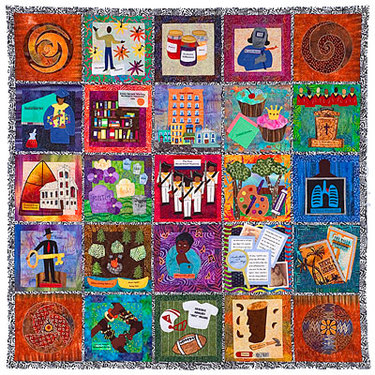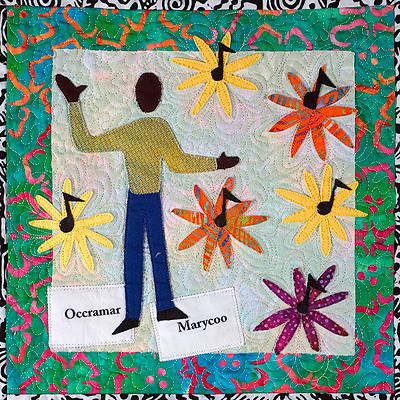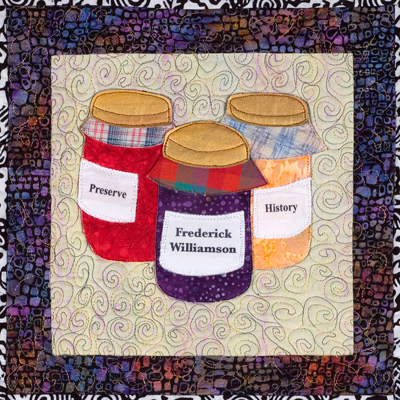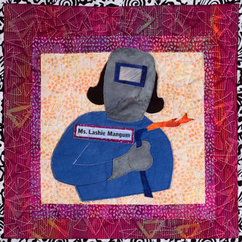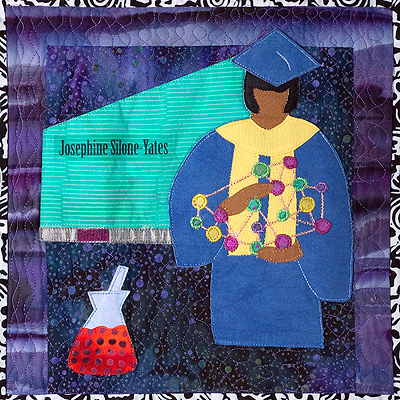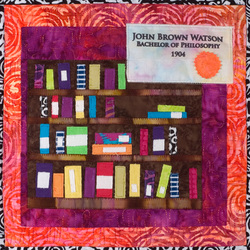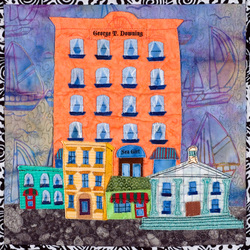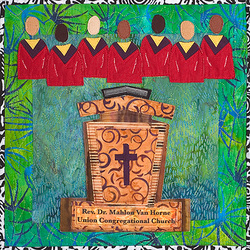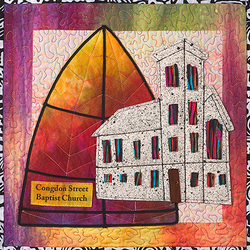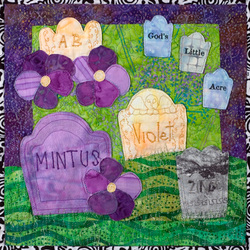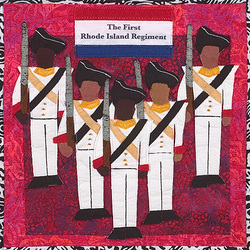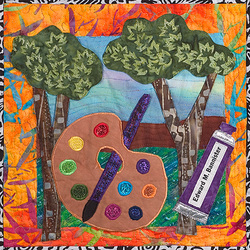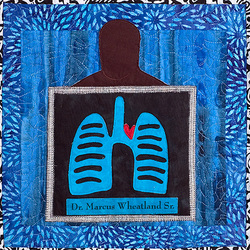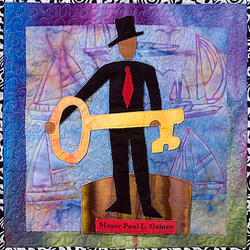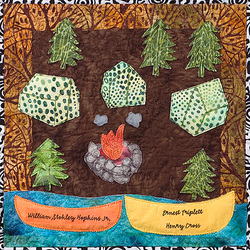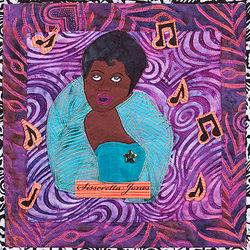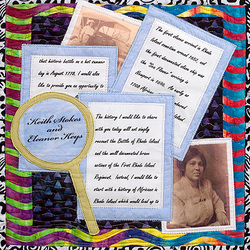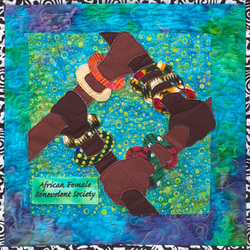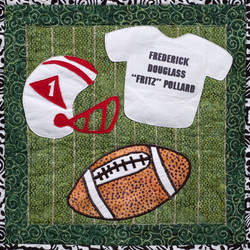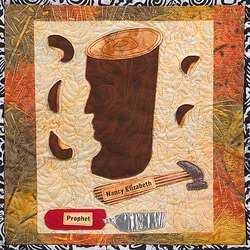Celebration of Rhode Island Heritage for Roger Williams University DetailsI was commissioned by Roger William University to create a quilted wall hanging for the university that commemorates African American Heritage in Rhode Island.
Listen to hear about the people featured on the quilt and how I made it. |
|
Occramar Marycoo
Mr. Marycoo who arrived in Newport from Ghana as a slave at age 13 was sold to the Gardner family. He was the early founder of the Free African Benevolent Society in 1780. Marycoo taught and composed music in Newport. In 1824 he led a group of Africans from Newport and Boston to return to Africa (Liberia). Today, he is recognized as one of America’s first African (American) composers. |
|
Frederick C. Williamson
Frederick C. Williamson, Chairman and State Historic Preservation Officer served on the Rhode Island Historical Preservation and Heritage Commission 1969 - 2010. The Commission is the state agency for historical preservation and heritage programs. The Commission operates a statewide historical preservation program that identifies and protects historic buildings, districts, structures, and archaeological sites. Source |
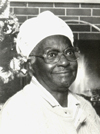
Ms. Lashie Mangum
Ms. Mangum and her husband migrated from Wake County, North Carolina to Rhode Island in 1935 looking for work. They were both hired by Walsh-Keiser Ship Yard in Providence. Kaiser played a key role in producing ships for World War II. Ms. Mangum was their first African American female welder. Mr. Mangum, who was a certified burner, became a foreman at the company. They lived by four core values which they passed on to their family: “dignity, value, self-worth, and respect for others. The Mangums worked at Kaiser many years before returning to North Carolina. Several members of their family reside in Providence to this day. Source |
|
Josepheine Silone-Yates
Ms. Silone-Yates graduated valedictorian of Rogers High School class of 1877 in Newport, R.I. From 1879-1889, Yates was head of the department of natural science at Lincoln Institute (now Lincoln University). She was the first woman to be named a full professor at the institution. She left Lincoln Institute to marry William Ward Yates in 1889. In 1902 she returned and became the head of the department of English and history. She later served as the advisor to women. Josephine remained at the Institute until 1910. |
|
John Brown Watson
Among the earliest African American alumni of Brown University (class of 1904), Mr. Watson had a distinguished career in the historically Black colleges of the South. His papers, contained at Brown University Library, cover topics such as: African American education; the role of the African American woman as Christian homemaker and as community leader in education; and land reform (creation of farms and rental of property to poor African Americans). Source 1 |
|
William T. Downing
Mr. Downing owned property and businesses in Newport between 1840 and 1900. He was known as one of the wealthiest African Americans in the United States at the time. Downing, who owned a catering business, opened the Sea Girt Hotel on Bellevue Avenue in 1854 and later opened other retail establishments on the “Downing Block” of Bellevue Avenue. He was influential in local policy making and civil rights initiatives in the area. Downing worked toward the desegregation of the public schools in Newport. At one time, Mr. Downing was in charge of the dining room and café at the Capital for the U.S. House of Representatives. |
|
Duchess Quamino
Born in Africa in 1739, Duchess Quamino arrived in Newport sometime in the 1750s. Ms. Quamino, was a slave who bought her freedom baking. She lived in the home of William Ellery Channing at 24 School Street in Newport. She came to be known as the “Pastry Queen of Rhode Island.” After she was no longer a slave, she continued to bake from Mr. Channing’s kitchen. The Channing home still stands at 24 School Street in Newport. |
|
Reverend Dr. Mahlon Van Horne
Mahlon Van Horne became the pastor of the Union Congregational Church (One of the first free black churches in America) in 1869. He was the first black to serve on the Newport School committee and was also the first black to serve in the Rhode Island legislature. Van Horne was elected a Representative to the State General Assembly three times. President William McKinley appointed him to the US Counsel to St. Thomas, WI in 1896. Van Horne later took up missionary work in Antigua in the West Indies. |
|
Congdon Street Baptist Church
Known locally as “the friendly church on the hill”, Congdon Street Baptist Church is one of the oldest black congregations in Rhode Island, located at 17 Congdon Street in Providence. 1819 - A gathering in the First Baptist Meeting House 1820 - African Union Meeting and Schoolhouse Society is opened 1840 - The Meeting Street Baptist Church is organized 1875 - Name changed to Congdon Street Baptist Church 2004 - Celebrating 185 years of religious heritage in Rhode Island |
|
God's Little Acre
Newport is home to the historically significant black burial ground known as God’s Little Acre. The burial ground located on Farwell Street, has been noted as having some of the oldest collection of markers of free Africans and slaves dating back as far as the 1600’s. Zingo Stevens, a stone cutter and slave who worked for John Stevens, signed his name to his brother’s headstone. His signature may be the oldest recorded African-American artist signature. Mintus Thurston was the last colored undertaker at God’s Little Acre. Many women at the time were named Violet. |
|
The First Rhode Island Regiment
The Regiment, a group of freemen and slaves, were enlisted by George Washington to fight in the Revolutionary war. They fought the British in the Battle of Rhode Island in Portsmouth. The Regiment's distinguished service pushed the General Assembly to pass the Negro Emancipation Act in 1784, providing for a "gradual emancipation" of slaves, said Keith Stokes. The lawmakers decreed that after March 1784, male children born to slaves would be free at age 21; females at 18. Source 1 | Source 2 |
|
Edward M. Bannister
Edward Bannister, famous for his landscapes and seascapes was the first African American to receive a major national art award. He was awarded the first-prize bronze medal at the Philadelphia Centennial Exposition of 1876 for the painting, "Under The Oaks. Bannister was one of the original board members to start Rhode Island School of Design. A gallery at Rhode Island College is named in his honor. |
|
Marcus Fitzherbert Wheatland
Dr. Wheatland was married to the granddaughter of George T. Downing. He is considered to be the first African American physician to live and practice in Newport. Dr. Wheatland served on the Town Council of Newport from 1910 through January 1914. He gained a national reputation in his field and is claimed to be the first African American radiology specialist in the U.S. Dr. Wheatland was appointed to the Board of Trustees of Howard University in 1910 and served on the Board until 1934. In 1994, West Broadway was renamed Dr. Marcus F. Wheatland Boulevard in his honor. |
|
Sisseretta Jones
Sisseretta studied voice at the Providence Academy of Music, and the New England Conservatory. She sang in New York's Madison Square Garden, the Chicago World Fair in 1893, and for several United States Presidents. Sisseretta led a troupe of singers and musicians on tour through the United States and abroad. Jones was given many gifts from admirers, among them, a bar of diamonds and emeralds from the citizens of St. Thomas, an emerald shamrock from the Irish people of Providence. She often wore her 17 medals across her chest during performances. Source |
|
Keith Stokes & Eleanor Keyes Keith
Keith Stokes and Eleanor Keyes two Rhode Island historians have been documenting the state’s history for many years. Keyes has received numerous awards for sharing her knowledge of black history. Her family moved to Newport in about 1891 from VA. Mr. Stokes, Executive Director of the Newport Chamber of Commerce is a native of Newport. Mr. Stokes’ writings and advice were instrumental in informing the research for this quilt. He is a frequent speaker on community and regional planning, historic preservation, and other topics. |
|
Rudolph Fisher
Rudolph Fisher was a novelist, short story writer, and leading figure of the Harlem Renaissance. His first published work, "City of Refuge", appeared in the Atlantic Monthly of February 1925. He went on in 1932 to write The Conjure-Man Dies, the first noted black detective novel. Fisher was also a physician (with a specialty in radiology), dramatist, musician and orator. Source |
|
Frederick Douglas "Ftitz" Pollard
Pollard a member of the Brown University class of 1919 achieved a number of firsts in his lifetime: the first of two African American players in the NFL in 1920. He became the first African American to play in a Rose Bowl Game. He was the first black quarterback to win a National Football League championship (with the Akron Pros), first African American coach in the NFL, and founder of one of the nation's first black-owned securities firms (F.D. Pollard and Co., in Chicago). Source 1 | Source 2 |
|
Nancy Elizabeth Prophet
Born in Warwick Rhode Island, Ms. Prophet was the first African American to graduate from Rhode Island School of Design with a degree in painting and freehand drawing. She spent much of her career in exile before gaining international recognition for her work as a sculptor. She taught at Spelman College in Atlanta. Nancy had a one-person exhibit in 1945 at the Providence Public Library and her pieces were part of an exhibit at the Bannister Gallery of Rhode Island College in 1978. Source 1 | Source 2 |
More about this project
The project manager, Ashley Tully, described the project as follows. “I am working on a project at Roger Williams University that requires purchasing of/commissioning an artist for a piece that will be permanently displayed in an African American heritage classroom - currently under construction. The university is interested in a quilt for that space that would capture African American history and symbolism.
To give you an idea of the project, we currently have a 53,000 sf academic building under construction called the Global Heritage Hall. It will house faculty offices, a 3 story atrium and a variety of teaching spaces of which 7 rooms will be heritage classrooms. These heritage classrooms will reflect the culture of the following heritages which are based on important local cultural demographics (worth nothing, we don't have enough space to include all heritage groups): Native American; Portuguese, Italian, African American, Latino, Bristol (town of) and Irish. Each room will showcase photographs, maps, facts and an art piece specific to the heritage.”
To give you an idea of the project, we currently have a 53,000 sf academic building under construction called the Global Heritage Hall. It will house faculty offices, a 3 story atrium and a variety of teaching spaces of which 7 rooms will be heritage classrooms. These heritage classrooms will reflect the culture of the following heritages which are based on important local cultural demographics (worth nothing, we don't have enough space to include all heritage groups): Native American; Portuguese, Italian, African American, Latino, Bristol (town of) and Irish. Each room will showcase photographs, maps, facts and an art piece specific to the heritage.”
My proposed quilt
The quilt design is contemporary style incorporating a variety of brightly colored fabrics and threads. The design is composed of 5 rows of contiguous twelve inch squares. The four corner squares feature Roger Williams University heritage medallions from America and Africa to highlight the mixed heritage of the African American classroom. Each of the twenty one inner squares is a unique composition that highlights a person or heritage concept.
The quilt will be accompanied by a legend that includes: the name of each square, significant dates and a brief synopsis about the featured person. I will also include bibliographical references so the viewers can learn more about these people.
My goal was to include people and places from the distant past as well as contemporary figures.
Some design assistance and illustration was provided by Page Hayes. "Working with Sandra is always a lot of fun, but I'd never worked with her on a quilt, let alone one as complex as this one," she says, "and I learned a tremendous amount about the history of some of Rhode Island's great contributors"
The quilt will be accompanied by a legend that includes: the name of each square, significant dates and a brief synopsis about the featured person. I will also include bibliographical references so the viewers can learn more about these people.
My goal was to include people and places from the distant past as well as contemporary figures.
Some design assistance and illustration was provided by Page Hayes. "Working with Sandra is always a lot of fun, but I'd never worked with her on a quilt, let alone one as complex as this one," she says, "and I learned a tremendous amount about the history of some of Rhode Island's great contributors"
